
The Cobblestone Historic District is located along state highway NY 104 in Childs, New York, United States. It comprises three buildings that exemplify the cobblestone architecture developed to a high degree in the regions of upstate New York near Lake Ontario and exported to other areas with settlers. It is the location of the Albion-based Cobblestone Society's Cobblestone Museum.

St. John the Evangelist is a historic Roman Catholic Church at 2270 Massachusetts Avenue in Cambridge, Massachusetts.
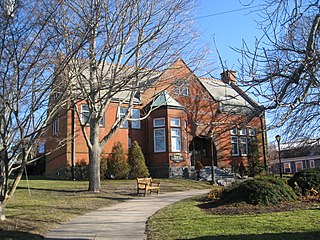
Eldredge Public Library is the public library of Chatham, Massachusetts. It is located at 564 Main Street, in a National Register-listed Romanesque Revival building donated by Chatham native Marcellus Eldredge. It was designed by Boston architect A. M. Marble.
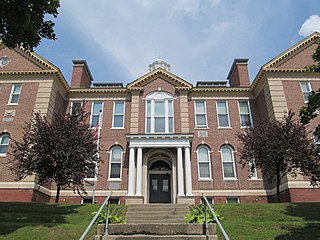
The Old Lenox High School building, also formerly known as the Lenox Elementary School and the Marguerite E. Cameron Elementary School, is a historic school building at 109 Housatonic Street in Lenox, Massachusetts. The building was constructed in 1908, and housed the town's high school until 1966, when Lenox Memorial High School opened. The building had been converted into an assisted living facility, and then converted again in 2017 into low-income-housing apartments for seniors - now known as Lenox Schoolhouse Apartments. The building was listed on the National Register of Historic Places in 2004.

US Post Office–Williamstown Main is a historic post office at 56 Spring Street in Williamstown, Massachusetts. Built in 1932, it is an architecturally significant local example of Classical Revival architecture. It was listed on the National Register of Historic Places in 1986.

The US Post Office—South Hadley Main is a historic post office at 1 Hadley Street in South Hadley, Massachusetts. Built in 1940 as part of a federal government jobs program, it is a prominent local example of simplified Classical Revival architecture. The building was listed on the National Register of Historic Places in 1986.

The House at 6 S. Marble Street in Stoneham, Massachusetts, is a rare early 19th century worker's house, and the only significant survivor of the early quarrying industry in Stoneham. It is a wood-frame house, two stories high, five bays wide and one room deep, with a side gable roof and a granite foundation. It has simple cornerboards and door and window trim. Houses like this were somewhat common on the early routes through the town, of which South Marble Street is a relatively undisturbed surviving fragment. This house was built about 1810.

The Malvern Road School is a historic school building on Malvern Road and Southbridge Street in Worcester, Massachusetts. Built in 1896 and enlarged in 1907, it is a high quality example of Beaux Arts and Renaissance Revival architecture. It is also significant as a well-preserved work of the local architectural firm Fuller & Delano. The building was listed on the National Register of Historic Places in 1984. The building has been converted to residential condominiums.

Saint Mary of the Assumption Church, Rectory, School and Convent is a historic church complex at 67 Harvard Street, and 3 and 5 Linden Place, in Brookline, Massachusetts in the Archdiocese of Boston. It was the first Roman Catholic Church in Brookline, and the first in the nation to bear the name. Most of its buildings were built between 1880 and 1906, and are reflective of the growth of the area's Irish immigrant community during that time. The complex was listed on the National Register of Historic Places in 1985.

The Beaman Memorial Public Library is the public library of West Boylston, Massachusetts. It is located near the town common, at 8 Newton Street, in an architecturally distinguished Colonial Revival building constructed in 1912 to a design by Worcester architect Lucius Briggs. The building was listed on the National Register of Historic Places in 2016.
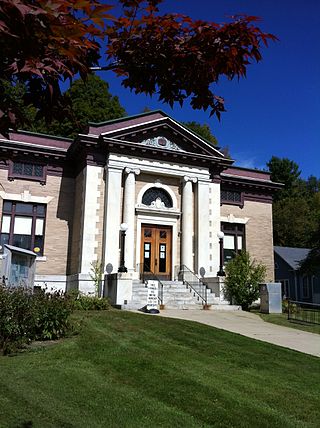
Ramsdell Public Library is one of two public library buildings of Great Barrington, Massachusetts. It is located at 1087 Main Street in the Housatonic village, in a two-story Beaux Arts building erected c. 1908. The building was a gift to the town by T. Ellis Ramsdell, fulfilling a bequest by his father Theodore, owner of the Monument Mills. It was designed by Boston architects McLean & Wright, with a sympathetic rear addition designed by the Pittsfield firm of Harding & Seaver. It was listed on the National Register of Historic Places in 2014.

Hill's Academy is a historic school building at 22 Prospect Street in Essex, Connecticut. It is now the home of the Essex Historical Society, and was also historically known as the Red Men's Hall because it served as an Improved Order of Red Men lodge. It is a two-story Greek Revival building that was built in 1832, and was used as a school until 1910. It was used by the Improved Order of Red Men between 1915 and 1954. The town then established the Essex Historical Society to receive the property and to preserve local history. The building was listed on the National Register of Historic Places in 1985.
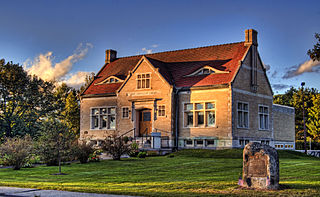
The Abbie Greenleaf Library is the public library in Franconia, New Hampshire. It is located at 439 Main St. in the center of the main village, in a Jacobethan building designed by William H. McLean and built in 1912. The building was a gift to the town from Charles Greenleaf and named in honor of his wife. Greenleaf was owner of the Profile House, a major resort hotel in Franconia. The library had an addition designed by Carter & Woodruff of Nashua built in 1971. The building was listed on the National Register of Historic Places in 2003.

The Pine Street School is a historic schoolhouse at 13 Pine Street in Northfield, Massachusetts. The school was built in 1904 and served as such until 1940, and represents a well-preserved specimen of an early 20th-century school building. It was listed on the National Register of Historic Places in 2002.

The Lower Main Street Historic District of Lee, Massachusetts encompasses the historic center of the town. It is centered on the junction of Main and Park Streets, where the center of the town was laid out when it was established in 1760. Although a meeting house was erected on this site, that structure was torn down, and the space was converted into a town common, a function it continues to serve today. The district also includes a portion of the business district, running along Main Street. The district was listed on the National Register of Historic Places in 1976.

The Old Kennebunk High School, also known as the Park Street School, is an historic former school building at 14 Park Street in Kennebunk, Maine. Built in 1922–23 to a design by Hutchins & French of Boston, Massachusetts, it is historically significant for its role the city's education, and architecturally as a fine example of a "modern" high school building of the period with Colonial Revival styling. It was listed on the National Register of Historic Places in 2011.
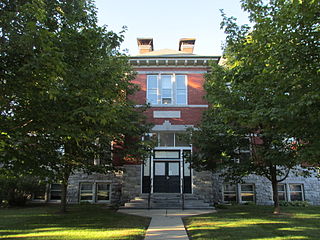
The Cora B. Whitney School is a historic former school building at 814 Gage Street in Bennington, Vermont. Built in 1897, it served as one of the town's primary schools until 1994, and was converted into senior housing in 1999. It is architecturally an important early local example of Colonial Revival architecture, and was listed on the National Register of Historic Places in 2001.
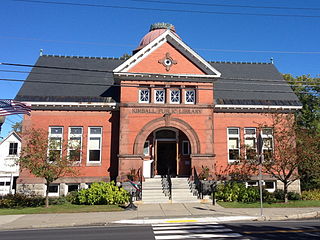
The Kimball Public Library is the public library serving Randolph, Vermont. It is located at 67 Main Street, just north of the town center, in an architecturally distinguished building donated by Col. Robert Kimball, a Randolph native. Built in 1902, it was listed on the National Register of Historic Places in 1985.

The Richwood Estate is a historic house on United States Route 7 in southern Swanton, Vermont. It was built in 1871 for C.W. Rich, owner of a local lime processing company, and is a distinctive example of Second Empire architecture using native materials. It was listed on the National Register of Historic Places in 1988.

The Peoples Academy is a historic high school in Morrisville, Vermont.























